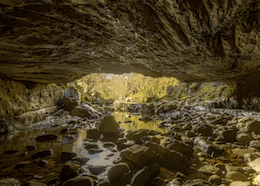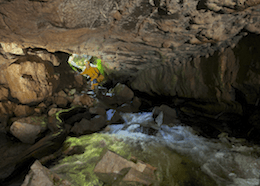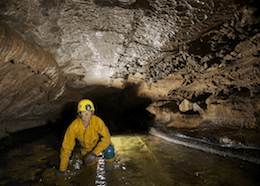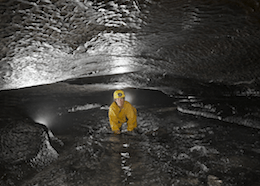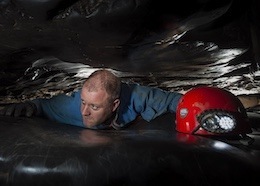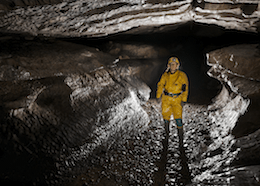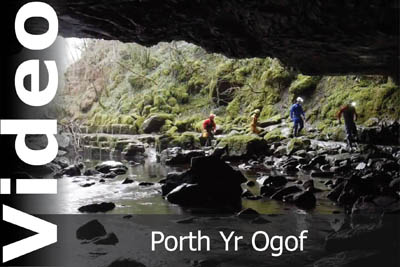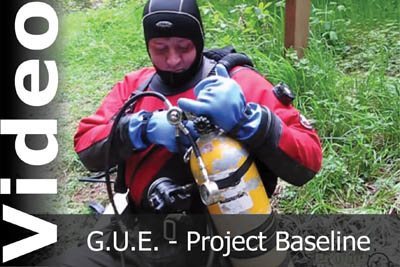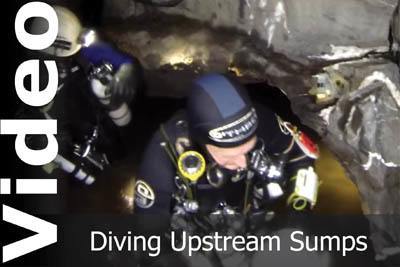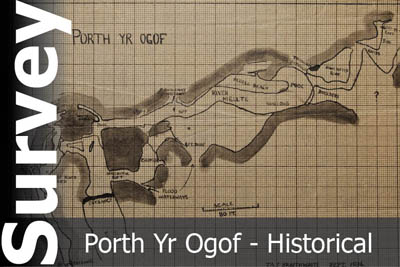Overview
Porth Yr Ogof (translated as the gateway to the cave) boasts the largest entrance of any cave in Wales at over 17 m wide and almost 5 m tall. Porth Yr Ogof was once operated as a showcave, but is now managed by the Brecon Beacons National Park Authority on a 999 year lease.
A managed pay and display car park adjoins a BBNPA visitor centre that is generally manned by a warden. The maze of passages with multiple entrances and easy access has made this the most popular cave in South Wales for outdoor activity groups. The cave is estimated to have over 30,000 visitors per year. Length 2,200m
Altitude 229m
Grid SN 92820 12415
History
The cave has long been known and below is a summary of key early records made of this cave
- 1698 Edward Llwyd (Lhuyd) mentions the cave in a letter to John Ray
- 1804 Description by Benjamin Malkin in The Scenery, Antiquities and Biography of South Wales
- 1805 Description by Theophilus Jones in The History of the County of Breknock
- 1813 Description by G. Nicholson in The Cambrian Travellers Guide
- 1836 Description by Thomas Roscoe in Wanderings and Excursions in South Wales
- 1928 Described by F. J. North in The River Scenery at the Head of the Vale of Neath
- 1936 Explored by the Wessex Cave Club and the Yorkshire Ramblers' Club
- 1937 Explored by E E Roberts and Gerard Platten and first survey drawn by T.A.J. Braithwaite - published in Caves and Caving 1938
Location
The cave is accessed from a secure pay and display car park and Cwm Porth Information Centre staffed by a Brecon Beacons National Park Warden. A screened changing area and toilets are avialable at the site.Ystradfellte Google map showing the location of the 15 Porth Yr Ogof entrances and other caves in the area.
Location map - click marker to show entrance photo
Access
No known access restrictions.
Description
The cave has 15 different entrances leading to over a mile of accessible underground passageways which makes this very popular with outdoor groups to introduce people to caving. In normal weather conditions a dry rocky river bed leads up to the main entrance to the cave, but following rain this may quickly become a raging torrent as the Afon Mellte (the Lightning River) lives up to its name and quickly makes the cave inaccessible. Care must be taken in wet weather. Another sinister danger in this cave is the resurgence pool, where the water leaving the cave is forced through a narrow passage, in doing so it has scoured out a 7 m deep pool with underwater ledges, this coupled with the strong undercurrents created by the flow of the water has made this the most dangerous location in any British cave. In this short section of cave 10 people have drowned all within the sight of daylight, the dangers here should not be underestimated, signs in the cave before the pool warn of the danger and direct you to alternative exits.
The Main Cave
The main cave is accessed via a limestone walkway on the east side of the main entrance which leads into the large day lit entrance chamber. The large passage in the right hand wall of the main chamber leads to the Right Hand Series. A small entrance further down and about 1.5 m up the wall leads to a small passage that takes you to Sump 6. Ahead the passage soon reaches water at the White Horse Pool which is several metres deep and takes its name from the equine appearance of the white exposed calcite vein on the wall above the pool. On the left of the main chamber are five passages, the first is a large alcove. The second passage leads to a low wide chamber that connects to the Upper Stream Passage and an entrance often referred to as the Tradesman’s Entrance. The three final passages on the left of the chamber all lead to the lower section of the Upper Stream Passage. The Upper Stream Passage follows downstream to Sump Five and deep water to connect to White Horse Pool. Beyond the White Horse Pool the stream passage is quite impressive with black vertical walls and deep water for about 80 m. The water becomes shallower and the passage wider as the Great Bedding Cave is reached and the passages of the Right Hand Series connect to the main passage. A passage joins here on the left hand side with water issuing from Sump 10. Going up this passage it passes the sump 10 inlet and continues as a low bedding for some distance to eventually reach a long duck with little airspace that links to the main cave just downstream of White Horse Pool. Further downstream the roof raises by about a metre and the cave is seen at its widest point at over 35 m across. A large shingle bank occupies the left hand side of thepassage with the stream flowing on the right. A wade through deep water leads to entrance I on the left while following the water down a series of short rapids entrance J can be accessed over the shingle bank on the left. Following the water further downstream leads to the final lake and the route to the resurgence pool where daylight can be seen. Signs in the cave here warn against crossing the pool directing you to alternative exits.The Maze
The Maze can be entered via several routes from the Right Hand Series or also from two entrances (D1 & D2) below the cliff face to the west of the Main Entrance. The Maze is a very complex area of passages that lie to the north of the Right Hand Series where the survey is of only general use. The passages are often formed on two levels in bedding planes top and bottom of a prominent slab of limestone. In many places there are holes where the two levels interconnect. In this area there are two entrances that lead back to the surface, a low crawl through a long muddy puddle leads to a boulder climb up to the surface - entrance D1. Just to the west of the Main entrance is a tight squeeze down through boulders into passages close to the Right Hand Series - entrance D2. This is constricted and has few footholds in the lower section making it much easier to enter than exit. The passages in the Maze all tend to loop back towards a large passage witha pool of static water - The Creek which leads towards the Great Bedding Cave.The Right Hand Series
The Right Hand Series can be entered via a large passage on the right inside the main entrance or via a climb up to a flat out bedding crawl just inside the main entrance. Several passages sand crawls can be seen to head off to the right, leading north into the Maze. The main passage veers left to pass below a couple of tall avens where the pitch entrances G and H enter the cave. Just beyond and to the right is a tight bedding squeeze - The Letterbox, while just beyond daylight can be seen from the free climbable entrance F. Crawls to the right will lead to the Creek while following the main passage towards the sound of running water leads to the Great Bedding Cave.The Creek and Hywel’s Grotto
The Creek starts just to the southern end of the Maze where shallow pool gives way to a fine, dry scalloped limestone floored passage. Routes in from the Right Hand Series join from the left while a prominent slope on the right leads up to a long bedding passage that leads via some low wet crawling to eventually arrive in Hywel’s Grotto, a small chamber with some calcite flows, formations and calcite pools. A fine wet crawl then follows through gour pools to reach the end where the passage becomes too low after a climb down a short calcite cascade. The Creek continues past four more passages on the right that all lead towards Hywel’s Grotto passage and soon enters the Great Bedding Cave. Upstream the water becomes deeper just beyond a prominent drop in the roof level while downstream passes through the widest section of the Great Bedding Cave.
The Entrances
The naming system used here reflects that employed by the University of Bristol S.S. on their original survey of Porth Yr Ogof which can be downloaded from this link.
Entrance A
The most northern entrance leading directly into sump 1 of interest to divers only.Entrance B
Known as the Cwmbran entrance it is located just above the river bed that gives access to sump 2 upstream and sump 3 downstream.Entrance C
This is now most commonly referred to as the Tradesman’s Entrance, a name which has been applied to several entrances to in the past but seems to have stuck most firmly to this one which is also known as Entrance No 1. It is located at the foot of an impressive cliff to the east of the Main Entrance where a moderately large entrance gives access to the underground stream as it emerges from the upstream sumps. This feature has apparently been formed by the partial unroofing of the stream passage by the progressive collapse of the sides of the main river gorge. This alcove in the cliff may also at one time have been the main sink. Downstream the tunnel can be followed in fast flowing water to a sump just before its junction with the main cave a short distance inside the main entrance. A series of bedding developments and sand chambers on the west side of this passage interconnect between this streamway and the main cave.Entrance D1
In the steep cliff at the west side of the main entrance, a number of enlarged joints give access to an extensive three dimensional maze. The lowest level of the maze consists of a complex of sandy passages with percolation water entering from the west side of the valley. This entrance is a climb down boulders to enter a small chamber with a low crawl through mud and water to enter the northern section of the maze.Entrance D2
Entrance D2 is located just west of the main entrance, the polished rocks near the cliff face giving away its location. The route down is very confined and there are few footholds in the last section, making this much easier on the way down than trying to exit.Entrance E
This is a huge natural arch 17.5 m wide and 5 m high at the base of a cliff into which the river bed leads. It is only in wet weather, however, that the main river flow sinks here; the only water entering the system in normal conditions being that which emanates from Porth-yr-Ogof Rising just upstream from the entrance. This entrance gives direct access to an impressive through system about 270 m long. This starts as a broad, boulder floored cavern which leads to the main canal a deep water filled, passage 80 m long. This leads tum to the main bedding cave which has a boulder floor and a low roof which spans as much as 30 m. This part of the cave becomes intermittently strewn with tree trunks and other debris which had been washed into the cave during flood conditions. A major inlet joins the main stream just upstream of the main bedding cave.Entrance F
Entrances F, G and H are a series of avens have breached the bottom of the dry river bed above the main cave. They can be descended to enter the lower reaches of the maze and a large dry oxbow which is a bypass to the main stream canal. This entrance has a fence and gate to protect it and is free climbable. A 15 m handline rigged from natural belays is advised for this entrance as there are few footholds on the lower part of the climb down.Entrance G
On the opposite side of the footpath to the fenced entrance are two further entrances located amongst boulders with trees above. This entrance links with the following one a few metres underground to descend 15m to the cave below and is not generally descended.Entrance H
This entrance is generally used for those wishing to descend the 15m pitch down into the passage below. Rigging is done from the boulders and trees around the entrance, but lack of suitable belays means that a free hang is not achievable in the cave. An entrance really only suitable for rigging with ladders.Entrance I
Entrances I and J are also sometimes known as Tradesman’s Entrance (see C above). They are two large collapse features formed along the line of a fault in the dry river bed above the cave giving access to the main bedding cave.Entrance J
These are also sometimes known as Tradesman’s Entrance (see C above). They are two large collapse features formed along the line of a fault in the dry river bed above the cave giving direct access to the main bedding cave. (This was the original Tradesman’s Entrance on the T.A.J. Braithwaite survey)Entrance K
A skylight entrance in the roof of the passage, unlikely to be passable.Entrance L
An entrance to the east of the resurgence located on a rock bench overlooking the resurgence which is only passable to the smallest of cavers.Entrance M
An alternative exit to the east of the resurgence leading to a rock bench overlooking the resurgence. A low entrance leads to a tall passage with several areas of false floor evident. This heads north to meet the main bedding cave at a low wet grovel over shingle and debris.Entrance N - Resurgence
WARNING: DO NOT ENTER THE RESURGENCE UNLESS YOU ARE WEARING WETSUIT OR A LIFE JACKETAfter the bedding cave the main stream flows into a deep pool just inside the downstream exit from the cave. The stream issues over a small waterfall before resuming its normal surface course. In normal conditions a small air space exists above the water allowing a swim through to the outside. The exit pool is about 7m deep and contain undercurrents which have contributed to several fatal accidents at this location. Above the resurgence a low bedding plane can be entered giving access to a rift which runs parallel to the main stream. This can be followed back to rejoin the main bedding cave above the exit pool.
Tackle
Aven Entrances G and H to Right Hand Series 15m - rigged from natural belaysEntrance F 15m handline advised
Wetsuits and buoyancy aids are advised for the deep water sections
Video
References
Cambrian Cave Registry for Porth Yr Ogof Wikipedia Entry for Porth Yr Ogof
Caves of South Wales | Tim Stratford | ISBN: 1-871890-03-9 | Published by Cordee
Selected Caves of Britain and Ireland | Des Marshall - Donald Rust | ISBN: 1-871890-43-8 | Cordee
Caves of the Mellte Valley | Allan Ockenden | ISBN: 1-871890-43-8 | Published by Cordee
Porth Yr Ogof, Breconshire | Peter Standing - Oliver Lloyd | Published by UBSS
The Secret World of Porth Yr Ogof | Martyn Farr | ISBN: 1-85902-559-5 | Published by Gomer Press
The Welsh Sump Index | Duncan Price | ISBN: 978-1-84728-209-5 | Published by Cave Diving Group
Limestones and Cave of Wales | Trevor D Ford | ISBN: 0-521-32438-6 | Published by Cambridge U.P.
Download a survey of Porth Yr Ogof | University of Bristol Spelaeological Society and CDG
Warnings
The greatest danger in this cave is the resurgence pool, where the water leaving the cave is forced through a narrow passage, in doing so it has scoured out a 7m deep pool with underwater ledges, this coupled with the strong undercurrents created by the flow of the water has made this the most dangerous location in any British cave. In this short section of cave 10 people have drowned all within the sight of daylight, the dangers here should not be underestimated, signs in the cave before the pool warn of the danger and direct you to alternative exits. You are advised not to exit via the resurgence pool.
Disclaimer
The photographs and information of this page has been provided to help cavers planning trips. Caving can be a dangerous activity, if you are interested in exploring caves please join a caving club so you can enjoy a safe introduction to this sport. Local caving clubs are listed on the links page or you can visit the 'New To Caving' website for more options.If you feel that any of the information is incorrect or should be updated please contact us.


